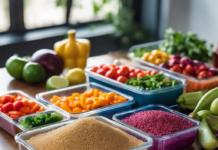Stress-free meal prep for the workweek starts with a smart approach to planning and organization. By crafting a flexible menu that caters to family preferences and schedules, shared meals become a joyful part of the day. Batch cooking favorite dishes guarantees ready-to-eat options, while proper storage maintains freshness. With a categorized shopping list and a consistent routine, the process becomes streamlined, providing a path to wholesome, homemade meals throughout the week.
Planning Your Weekly Menu
How should one begin the journey of planning a weekly menu? It all starts with understanding personal and family preferences while embracing the joy of shared meals. Gathering around the table with loved ones becomes more meaningful when meals reflect everyone’s tastes.
So, consider favorite recipes that have been passed down or discovered together.
Next, it’s important to take stock of what’s already in the pantry and fridge. This not only saves money but also reduces waste, fostering a sense of responsibility and community.
With these insights, one can sketch a flexible weekly menu that accommodates the ebb and flow of the week’s activities. By planning meals that everyone looks forward to, the anticipation of shared moments grows, strengthening bonds and creating lasting memories.
Organizing Your Grocery List
With a flexible weekly menu in hand, it’s time to simplify the grocery shopping experience by organizing an efficient grocery list. This process can foster a sense of community and ease for those who crave connection.
Begin by categorizing items by sections like produce, dairy, and pantry staples to streamline shopping and save time. Highlighting these categories helps avoid chaos in the store and guarantees nothing is forgotten.
Include quantities to match the menu’s needs, making certain to reflect on shared meals or snacks that build bonds. Additionally, checking pantries before heading out can prevent overbuying and encourage resourcefulness.
Efficient Shopping Strategies
Why not transform grocery shopping into a more efficient and enjoyable task with a few savvy strategies?
First, they should choose a consistent shopping day, turning it into a routine that feels comforting. Knowing the store layout can save time, so they should create a list organized by aisle.
It’s helpful to shop during off-peak hours, avoiding long lines and crowds. For a sense of community, they might engage with local vendors or farmers’ markets, supporting neighbors and finding fresher options.
Using apps for digital lists or store discounts can streamline the experience. They should stick to their list to avoid impulse buys, keeping their budget in check.
These strategies can make shopping a seamless part of their week.
Batch Cooking Essentials
Batch cooking is the secret ingredient to a stress-free workweek, offering numerous benefits that can transform meal times. By preparing larger quantities of favorite dishes, one can guarantee a constant supply of ready-to-eat meals, reducing daily cooking stress.
This method fosters a sense of community, as families can gather around the table without the rush. It also creates opportunities for shared culinary experiences, allowing friends and loved ones to bond over meal prep sessions.
Essentials for successful batch cooking include reliable kitchen tools, like a sturdy set of pots and pans, a sharp knife, and high-quality storage containers.
Choosing versatile ingredients that work in multiple recipes can add variety without extra effort. Embracing batch cooking can make anyone feel part of a mindful, connected community.
Storing and Reheating With Ease
Although meal prep is a time-saver, proper storage and reheating techniques are essential for maintaining flavor and safety. Containers should be airtight to preserve freshness, helping meals last longer.
Glass containers work well for both storing and reheating, as they retain heat evenly without absorbing odors. To foster a sense of community, people can share tips on social media, exchanging advice on the best storage practices.
Labeling containers with dates fosters organization and guarantees nothing is forgotten. When it’s time to reheat, microwaving with a damp paper towel can prevent drying out. Stirring halfway through reheating guarantees even warmth, enhancing the meal’s quality.
Quick and Simple Recipes
For those looking to simplify their meal prep routine, quick and simple recipes are the way to go. Embracing these recipes can help create a sense of community and shared experience, as everyone can relate to the joy of a delicious, no-fuss meal.
By focusing on straightforward dishes, anyone can whip up something tasty without spending hours in the kitchen. Think of a hearty stir-fry or a flavorful pasta salad—meals that come together swiftly yet satisfyingly.
These recipes not only save time but also provide a comforting sense of accomplishment. They offer a way for individuals to connect over the shared love of food that doesn’t require advanced culinary skills, making everyone feel like they belong at the table.
Using Versatile Ingredients
Quick and simple recipes lay the foundation for efficient meal prep, but the true magic lies in choosing versatile ingredients. By selecting items like chicken, quinoa, or bell peppers, one can create a variety of meals that suit different tastes and preferences.
These ingredients blend seamlessly into numerous dishes, from stir-fries to salads, allowing individuals to feel part of a community that values creativity and practicality in the kitchen.
Versatile ingredients also offer flexibility, making it easier to adapt to unexpected changes in meal plans or dietary needs. They bring people together, encouraging shared experiences and fostering a sense of belonging around the dinner table.
When everyone enjoys the fruits of smart meal prep, it strengthens connections and enriches daily life.
Minimizing Food Waste
Reducing food waste is an essential step in any meal prep routine, benefiting both the environment and the wallet. By planning meals thoughtfully, one can better utilize ingredients and avoid unnecessary purchases.
For a community that values sustainability, using every part of produce and creatively repurposing leftovers fosters a sense of shared responsibility.
Simple strategies like keeping an organized fridge help track ingredients nearing expiration. By batch cooking, individuals can freeze portions, ensuring nothing spoils.
Engaging with others in the community through meal swap events also helps minimize waste while building connections.
Ultimately, mindful meal prep not only cuts down on waste but also strengthens bonds within a group that shares the goal of living more sustainably and conscientiously.
In Conclusion
By thoughtfully planning and organizing, anyone can turn the intimidating task of meal prep into a stress-free routine. Crafting a flexible menu that caters to family preferences makes shared meals enjoyable. With efficient shopping strategies and batch cooking essentials, meals are ready in no time. Proper storage and reheating techniques guarantee freshness, while quick recipes and versatile ingredients keep things exciting. Embracing these practices minimizes food waste, allowing families to savor nutritious, homemade meals all week long.










